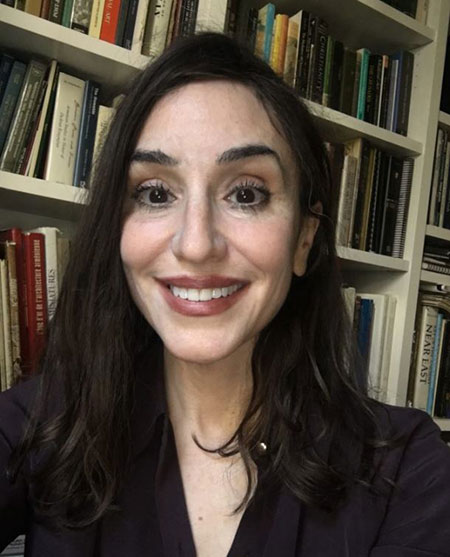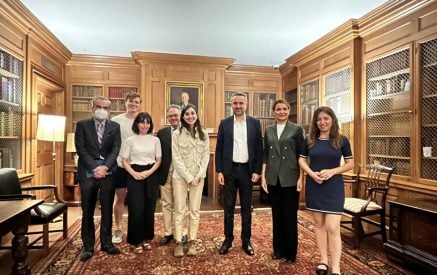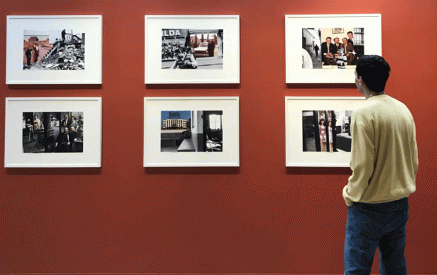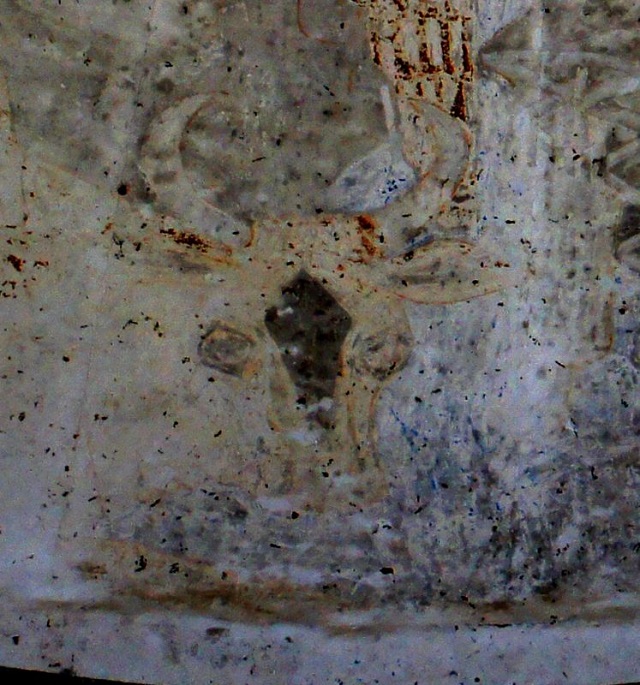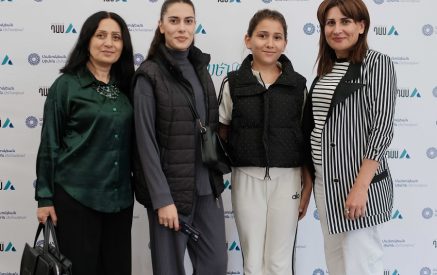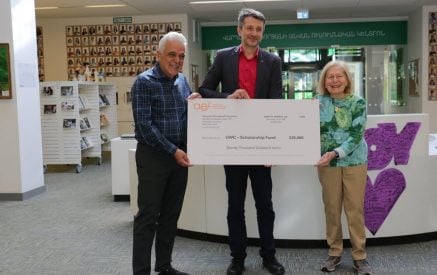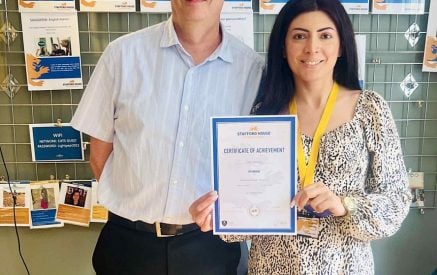by Harry Kezelian
The Armenian Mirror-Spectator
CAMBRIDGE, MA — Christina Maranci, the longtime professor of Armenian art history at Tufts University, was appointed to the historic Mashtots Chair in Armenian Studies at Harvard University this past summer.
As the first woman, the first person of Armenian descent, and the first art historian to hold the position, she brings a fresh perspective to the Harvard chair. She is also a member of a considerably younger generation than her predecessors, Robert Thomson and James Russell, though she is adamant to note the high esteem in which she holds these senior male colleagues.
Welcomed into Armenian Studies by Dedicated Mentors
Read also
Maranci was raised in an Armenian-American family in Connecticut, but Armenian culture per se was not necessarily a focal point of her childhood. With her father hailing from Istanbul, and her mother being American-born, their shared interests tended toward classical music and European culture. Art and culture was central to their household, though, Maranci says, and living close to New York City meant having easy access to the vast world of museums and other resources to learn about art.
Attending UConn – Stamford, Maranci took a course on “Art Appreciation.” “I had never heard of that,” she states. “And for me, a switch went on. It was a way to understand history that made sense to me, that wasn’t just a recitation of dates and names, but an immediate immersive connection with the past through visual material and culture. And for me it really was a revelation to realize that was a way of studying the past.”
Maranci first entered Vassar and thought she wanted to study Gothic architecture, but couldn’t find funding. At that time, she says “I had the great good fortune” of meeting Thomas Mathews of New York University (NYU), and Prof. James Russell and the late Prof. Nina Garsoian, both, then of Columbia, who were reinvigorating Armenian studies in the New York area.
The “Treasures in Heaven” exhibition of Armenian illuminated manuscripts organized by Mathews at the Pierpont Morgan Library in 1994 was a turning point for Maranci’s introduction into the world of Armenian Studies.
“I met Mathews, who introduced me to Garsoian, who let me audit her courses without paying the technically-required fee. And she took me under her wing,” Maranci said.
Historian and historical geographer Robert Hewsen was there at the time, too, Maranci noted. A trip to the ruins of Ani in what is Turkey now with Garsoian and a French tour group was another memorable occasion. The French tourists didn’t necessarily know who Garsoian was, but her commentary on the history, culture, and architecture of the site enthralled them. “By the end of the trip, the French were all eating out of her hand,” Maranci recalled. “She exuded authority and intellect, effortless.”
In regard to Garsoian’s recent passing, Maranci shared that, “I can’t believe she’s gone. She was a monumental figure in Armenian studies and produced so many students and so much good research. She was an extraordinary human being. She was the kindest and most hospitable person, with a wicked sense of humor. It’s a huge loss and it’s hard to imagine…I’m so grateful that I had time with her, and that she gave me the time of day. You have those people in your life who when you really need it, they are really there for you, and you never forget it. I’m always going to help others because I was always helped. [She was] an extraordinary mentor and a source of support.”
Making her name with Mren
Although mentored by Garsoian and the other towering figures associated with Columbia, Maranci eventually attended Princeton for her PhD. There she worked with Slobodan Curcic, a Byzantine scholar in the department of Art and Archaeology who focused on the medieval architecture of Serbia; she also studied with Peter Brown, “who was intensely interested in the Christian East and was very welcoming of an Armenian dissertation topic.” She also noted, “if you were a grad student in Art History, you were constantly talking to people in History and Classics and Religion.”
Her dissertation was on the legacy of Josef Strzygowski, the controversial art historian who claimed that Armenian architecture influenced the Gothic style which reigned in Europe’s High Middle Ages. But she became association in the popular mind with her work on the Cathedral of Mren, a seventh-century church which, like the ruins of Ani, is in Western Armenia.
“It is an amazing site and has been studied since Toros Toromanian and before,” Maranci said. “It is an extraordinary monument because of the way it bears witness to the seventh-century wars, between the Byzantines and Persians as well as the Islamic conquests. And it’s covered with inscriptions. And it names the [Byzantine] Emperor Heraclius. It can be studied architecturally, and in terms of its inscriptions and sculpture. The sculpture helps us understand the culture of the era, and how connected Armenia was to the Byzantine world.”
Heraclius was the seventh-century emperor known for his wars with the Sassanid Persians and his retrieval of the relic of the “True Cross” which was taken from Jerusalem by Persian forces. The Byzantine-Persian wars, according to some scholars, weakened both empires, setting the stage for the Islamic conquest of the Middle East.
Maranci is enthusiastic about the history which the site of Mren contains. “Why was it built? It calls Heraclius ‘the victorious Emperor Heraclius.’ We can crosscheck that with Sebeos’ history [a history of the era written by a contemporary Armenian writer, Sebeos]. It seems to have been built to express alliance with him. There is a sculpted lintel showing Heraclius returning the True Cross to Jerusalem, which was a crucial benchmark in terms of his success.”
“Mren and monuments like Mren, with inscriptions, are high quality eyewitnesses to history,” stated Maranci. “That gets to the other part, that it’s in a military zone on the Turkish side of border and this means that it’s difficult to access, and it hasn’t received the kind of attention that Ani has.” Maranci notes that this is the case for most Armenian historic sites in Turkey, besides Ani and Aghtamar. “This is the status quo in Turkey. Mren is in dire condition. The lintel is in great danger of collapsing. It’s a testimony to a period of time that’s not well known, but is also very fragile. There are many monuments in the same predicament, and this is something that we know all too well with the Artsakh war. Understanding the history and understanding that the monuments are ‘archives’ of that history,” is one important way that we can bear witness to the Armenian past of the region, Maranci concludes.
Heir to the Harvard Chair
Maranci is well aware of the historic importance of the Mashtots Chair. In regard to her appointment, “I’ll say personally, it’s huge, it’s exciting. It’s personally really moving because my mother and my aunt were both present at the inaugural dinner.” [The 1955 inaugural dinner for the National Association of Armenian Studies and Research (NAASR), which established the Harvard chair]. She continued, “It was an amazing feeling, to be here is really exciting, and I want to do a good job. I have big shoes to fill, when you think about Robert Thomson and James Russell, the minds they represent, I’m really humbled.”
Maranci’s background has prepared her well for the new role. “I’ve held the chair at Tufts for 14 years, and 6 years I’ve been department chair, so I’ve had experience thinking about how to shape what I study and what I teach. I have been invested now for many years in growing Armenian classes, Armenian art classes, but when I teach art, I teach a little history, culture, religion, language…I had 200 students in my class last spring. I think there’s potential for doing that at Harvard. I’m teaching that course this fall.”
Isn’t 200 students quite remarkable for an Armenian related course? “I’m going to be as welcoming and generous as I can. You get undergraduates interested. And that’s the base of interest. And from that you get majors, in art history, or in Armenian. And from there you start to produce doctoral students. What I find that I’m doing with doctoral students all over the place, I’m not just training the students, I’m teaching their advisors,” she explained.
Maranci noted that many dissertation advisors have no familiarity with Armenian history or culture. For example, she pointed out work being done on bronze mirrors that originated in medieval Anatolia; although some had Armenian inscriptions, this was somewhat ignored by scholars who classified them as “Seljuk” or “Islamic” based on artistic criteria, and who were unable to read Armenian.
She noted: “My job puts me in a position to build bridges. One of my jobs is not just to run a big undergraduate program, but to share doctoral students with other faculty so they can learn about Armenian culture as well. I want the chair to be connected to the Armenian community, but to Harvard too as an institution. I’m in [the departments of] Near Eastern Languages and Cultures, and History of Art and Architecture. And I see that as a great opportunity to spread more of the wealth of Armenian culture. There are a lot of bridges to build. Whether we’re talking about the Divinity School, classics, history. I’ve got a good start from my experience at Tufts.”
But her primary job, is, of course, as a scholar and researcher. “Even before [training doctoral students], my job is to do research and publication,” of which she has produced reams, as anyone can easily discover from her CV. She continued, “I’m producing that research, that’s the backbone of what I do. That painstaking work, which is all about details, is what’s necessary to teach with and to advocate with. If you don’t know why Mren is important, then you are not in the best position to teach and to advocate. And it’s also what I love to do, that’s important. It give me joy to work on medieval Armenian topics and when you have that joy, you can give it to others.”
In terms of whether the Harvard position holds a leadership role within Armenian Studies in the US, Maranci humbly brushed aside the suggestion and stressed cooperation: “There has to be building of connections across our chairs. Given [what has been happening] since the war, it’s important to find ways to be on the same team. This is the time. I’ve been involved in so many initiatives since the war with my fellow chairs. And that’s going to keep happening, and it has to keep happening,” she said. She added, however, that if she can leverage the status of a professorship at Harvard “to create better protection for Armenian culture and visibility for the Armenian community,” she will do so.
As for the future of the Armenian Studies field in general, she said: “I think that we can talk about new trends in terms of scholarship and some of the things that I see, I’m not the first person to notice them, the narratives that connect Armenia to other cultures. Of all the real ways that Armenia is connected to other cultures from Europe to East Asia.” She is happy that more scholars from various disciplines are gaining knowledge of the Armenian language and culture, as well as the incorporation of ‘digital humanities.’
“I also am glad to see rising numbers of women in the field in various disciplines. Even in art history, to see more women is great. And the last thing I’ll say is, newer fields like material culture are starting to come to the fore. There are some interesting projects now on film studies, dance, etc. It’s exciting to see Armenian studies branch out and deepen at the same time. And to see new players as well. It’s an exciting time and I’m hopeful about the future and what the next generation of students is going to bring.”
Protector of Monuments
One of the most valuable aspects of Maranci’s particular expertise puts her on the front lines of the protection of historical Armenian monuments which are now under threat in Karabakh (Artsakh) and have been for years throughout Azerbaijan and Turkey.
“I’ve been involved in so many conversations about the fate of the monuments, with the church and other NGOs [non-governmental organizations],” Maranci said. “It’s been really extraordinary to see how mobilized the Armenian community has been in the last 2 years. The more people that raise their voice the better. The situation is really dire. I’ve sent out open letters and organized events. I can also communicate at a level of talking with the World Monuments Fund and various bodies that do this work.”
As an expert on the Cathedral of Mren and other Armenian monuments in Eastern Turkey, Maranci has been involved in initiatives to protect that region’s monuments for many years now, and continues to do so. “Most recently we went to Turkey and I spent a day in Ankara with WMF [World Monuments Fund].” Maranci declined to discuss particulars but shared that, “The point is, there are projects underway to protect monuments at Ani and hopefully at Mren. These are delicate situations but what’s important is that I can present information that is documented about the monuments. It’s not spin. And this is really important to the people who can make decisions about the monuments, like the State Department and the WMF. ‘Here’s the research, here is what we know.’ And that helps people make good decisions.”
She feels that the same applies to Artsakh. “For almost 20 years, from my experience, what I can tell you is that as dire as things look right now in Artsakh, what I know is that things can change and things can change fast. Keep working, keep optimistic, and don’t get discouraged. It’s so easy to get discouraged. What helped me was to keep plugging away, and keep applying for various grants and projects.”
As a scholar, she does get tired of fact that the Armenian heritage is used as a pawn in international geopolitics. She explained, “There’s such a political game involved in the monuments and heritage and I find it to be bewildering. What I’m interested in is making sure the buildings stand up so that future generations can look at them and enjoy them. If I can help that process of making sure these buildings are still standing, that is what I will do.”
For example, she doesn’t care to engage in a semantic discussion about the differences between Armenians, Caucasian Albanians, Artsakh Armenians, or Artsakh Armenians that at some point used the term “Aghvank” (Albanian) in a regional or ecclesiastical sense.
“It’s just a way to erase Armenians from the region, it’s just a strategy,” she said of the controversy pushed forth by the Azerbaijani authorities. “That’s one of the great acts of violence being done here. It’s shocking that we’re in this position.”
Maranci is the author of four books, with her latest The Art of Armenia: An Introduction, which came out in 2018. Other books include Medieval Armenian Architecture: Constructions of Race and Nation, and Vigilant Powers: Three Churches of Early Medieval Armenia.




















































